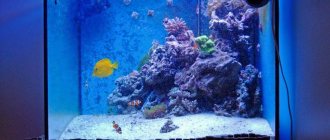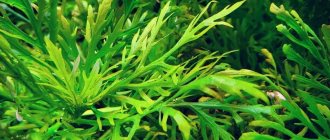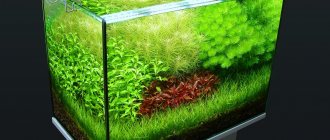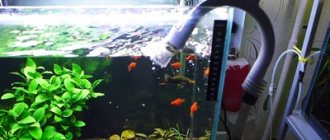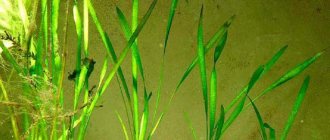I have been using various types of fallen leaves in my aquarium for several years now. It all started with large brown leaves that I saw in a local dealer's aquarium a few years ago.
I became interested in the purpose for which they are there, to which the owner said that exporters always supply demanding fish with several leaves in the water, and they supposedly contain some kind of medicinal substances.
I was intrigued and even received it as a gift since there was already an abundance of leaves. After which I brought them home, put them in the aquarium and forgot until they completely dissolved.
After a while, I recognized these same leaves on a website where they were being sold at auction as Indian almond tree leaves and after some thought I purchased a pair. The task was to understand whether they are really useful or all this is fantasy.
After initial positive results and further research, I switched to collecting local leaves and evaluating their usefulness for aquarists. Why not? After all, local driftwood and branches are also used for decoration, but why are leaves worse?
Now I constantly use fallen leaves in each of my aquariums, especially with fish that naturally live in water where the bottom is covered with such leaves. This is the wild form of cockerels, fire barbs, apistograms, badis, angelfish and other fish, especially if they spawn.
In the backyard
My work involves traveling and I spend a lot of time in different parts of the country. I collected and used leaves from scale oak (Quercus robur), sessile oak (Quércus pétraea), Turkish oak (Q. cerris), red oak (Q. rubra), European beech (Fagus sylvatica), hawthorn (Crataegus monogyna), palmate maple (Acer palmatum).
Cones of the European sticky alder (Alnus glutinosa) also turned out to be quite useful.
These plants are just a small part of everything that I have tried and I hope in the future I will be able to expand this list even more. Of course, I myself am in another country, and not all the plants that grow here can be found in yours, but I am sure that some, and perhaps many species will still come across.
However, still be careful when using fallen leaves, especially if you are keeping sensitive species.
Shelter for the winter
Shelter during the cold season is necessary for all plants, regardless of age or place of growth of almonds
If the garden is located in the southern zone, insulation for almonds is not so critical, but it is still better to take care of young seedlings. Of course, if the tree has already “grown” 4-6 meters, it will not be possible to cover or insulate its branches, but you can try to take appropriate measures regarding the trunk
All that remains is to stretch the insulation onto the frame - the bush will not freeze
Experts recommend insulating even frost-resistant varieties, such as Almond Stepnoy, also known as Low, Russian, Bobovnik, or Almondnik. Some varieties of this frost-resistant species are bushes rather than trees, but this does not make the taste and benefits of the fruit worse.
To protect the plant from the cold, you can take the following measures:
- In early August, remove the apical buds on the shoots. In this way, it will be possible to accelerate the lignification of the shoots and they will better withstand frost.
- Cover young (required) and mature (highly desirable) plants 15 cm or higher with breathable material - tufts of straw or a bunch of dry leaves. You just need to make sure that the covering material is not diseased, since humidity during a thaw or in early spring can contribute to the infection of the tree with pathogenic microorganisms. With the first snow, you can begin to form snowdrifts around tree trunks.
If the crown of young trees consists of relatively bendable shoots, they can be collected “in an armful,” tied with twine and wrapped in agrofibre. You can try to throw lutrasil on a more spreading and more elastic crown.
Why are fallen leaves needed in an aquarium?
The fact is that some aquarium fish, such as discus, can live their lives quite well in nature and will never encounter living plants. This is especially true for fish that live in water with fallen leaves on the bottom, where high acidity and lack of light make the habitat extremely unfavorable for plants.
There is no luxurious ground cover, dense thickets of longstem and crystal clear water. There are a lot of leaves at the bottom, the water is acidic and dark brown in color from tannins that enter the water from rotting leaves.
Dead leaves play a very important role in the lives of many species of fish, for example I have seen several hundred Apistogrammai spp per square meter rummaging through such foliage.
Almond tree - varieties
The best types of almonds were created on the basis of wild species and combine high nutritional characteristics with the ability to easily tolerate the vagaries of nature:
- Dessert - height up to 5 m. Blooms in May, buds are large, bright pink. The fruits are large, have a pleasant taste, and ripen in September.
- Foros - height up to 4 m, spreading crown. It blooms in May, the buds are medium-sized, pale pink. The fruits are large and soft-shelled. Zoned for the North Caucasus region.
- Slovenia - height up to 6 m, spherical crown. The first harvest is 6 years after planting. The fruits are large, easy to peel, and ripen in September.
- Nikitsky 62 – height up to 5 m, zoned for the southern regions. Afraid of frost, self-sterile. The fruits are sweet and contain a lot of oils.
Among the decorative varieties, one can highlight the three-lobed almond “Rosenmund”. This spreading plant, up to 3 m tall, is covered in bright pink terry buds in spring. Flowering occurs at the end of April even before the leaves appear. The flowers are medium in size, tightly pressed to each other. They exude a pleasant delicate aroma with a slight almond bitterness. The fruits are inedible and set extremely rarely.
What are the advantages?
Yes, it’s all about the tannins that fallen leaves release into the water. Adding dead fallen leaves has the effect of releasing humic substances, and this will lower the pH of the aquarium water, act as an antibacterial and antifungal agent, and also reduce the content of heavy metals in the water.
It has been proven that such water has a stimulating effect on fish ready for spawning, and helps fish that have suffered stress or suffered in a fight to recover faster. In my personal opinion, using leaves in an aquarium has many more advantages than disadvantages.
The color of the water in the aquarium serves as an indicator of how much tannins have accumulated. Water with an excess amount quickly changes its color to light brown, and this is easy to notice without resorting to tests.
Some do it differently. Place a separate bucket of water into which the leaves are poured generously and soaked.
If you need to tint the water a little, then simply take some of this water and add it to the aquarium.
You will notice that many tropical fish will become more active in brownish water and dim lighting.
Almonds: planting a seedling, brief instructions with photos
If zoned varieties are available for sale, the problem of purchasing planting material comes down to choosing between seedlings of decorative and table varieties. Grafted seedlings from a bona fide seller are guaranteed to have the properties of the declared variety.
When purchasing, you should take into account that for full fruiting, almonds need cross-pollination. Therefore, to obtain a harvest, it is necessary to plant several plants, preferably different varieties.
Planting a seedling is not a difficult undertaking:
1. Preparing the planting hole. The size of the planting hole will indicate the size of the root. For a one-year-old plant, a hole up to 60 cm deep and the same diameter is usually sufficient. The bottom should be covered with a layer of crushed stone, broken bricks and sand. This ensures the necessary drainage; excess moisture cannot harm the young plant.
2. The distance between the holes should be maintained within 3 m. This way, bushes growing upward and wider will not block each other from the sun.
3. The soil for filling the hole is fertilized with superphosphate (no more than 0.5 kg per plant), rotted manure (about 5 kg); Be sure to lime by adding 1 cup of dolomite flour or lime.
4. At first, the seedling needs support. A long pole, stick or bamboo support is stuck deeper into the center of the planting hole. The roots are distributed along the bottom of the hole, preventing upward bending.
5. When filling the hole, carefully ensure that the grafting site remains above the soil level.
That's all the basic wisdom of planting. Each plant should be watered abundantly; later, keep the soil around clean. Almonds do not tolerate root vegetation, even ordinary grass.
In the first year, the bushes grow reluctantly - mainly the root system develops. But the following years will delight you with the active growth of the bush. Almonds, with care and proper feeding, begin to bloom at the 4th year of life.
Are there any other advantages?
Yes, I have. I have noticed that the decaying leaves in the aquarium serve as a food source for the fish, especially the fry. The fry grow faster, are healthier and you can often see flocks of fry gathering in places where there are a lot of leaves.
Apparently the decaying leaves produce various mucus (since in water containing tannins the processes take place differently), which the fry feed on.
Well, don’t forget that this is a good nutrient medium for ciliates, which are simply wonderful to feed small fry.
Sights of Barcelona and Catalonia
Happy New Year to all readers of my blog! And also already coming on the heels of Orthodox Christmas and the Day of the Magic Kings (Reyes Magos), beloved by all Spanish children ! I apologize for the delays with information - holidays...
For Spaniards, Christmas is a family holiday, and New Year is a public holiday. Fireworks, cheerful companies, meetings with friends, dancing - all this is reserved for the New Year's Eve party. Spaniards often go with their friends somewhere in nature or to another city, and meet them there.
This year we also went to a campsite, which is located near the town of Ameia de Mar on the Costa Dorada. From Barcelona it is about two hours by car.
On the road we passed Vendrei, Tarragona, Salou, a nuclear power plant - a local horror story, the coastal block of which is closed, but the internal “invisible enemy in the mountains” is still working. From Ameya to the nuclear power plant it’s only ten kilometers...
Ameia de Mar is a fishing town with a poetic name, which when translated sounds like Sea Almond. (VIDEO at the end!)…
There are many tourists here in summer. In winter it is quiet, almost everything is closed with shutters. There is an interesting legend associated with Ameya de Mar. In 1891, a Greek ship was washed ashore here by bad weather. Local residents saved, fed, watered and warmed the crew, but the ship was less fortunate; it was broken up by the surf. The local population stole the boards for their own needs. To this day, several old houses have been preserved here, for the construction of which ship remains from a Greek ship were used.
The lagoon in which the historical part of the town is located was once called the almond lagoon. Nvaernoe, almond trees grew there. Now the town is surrounded by olive groves. In winter, a strong wind from the mountains often blows here - the mistral. The wind ruffles the olive trees, the curved, gnarled trunks creak, and the crowns turn white - this is the color of the olive foliage from the inside out. For two days the wind tossed the olive trees, but on the third it had mercy. And then the sun began to heat up - on the first of January we walked along the shore among flowers and palm trees at a temperature of 19 degrees.
Most campsites are closed during the off-season, but some accept tourists all year round. There are houses - bungalows. We paid 120 euros for two nights in a cottage with all amenities (and heating) for 6 people. It worked out to about ten euros per person per night. Naturally, we brought our own food for the festive and pre-holiday table. But there is always the opportunity to eat at nearby restaurants and bars in the nearby town.
For the New Year there is usually no such strict traditional menu as for Christmas. Perhaps because they celebrate the year in different companies, in different places, often spontaneously creating a menu. Since we were near the Bybatsky town, the menu was appropriate - seafood. On the morning of December 31st we went to the wholesale fish market, where the caught catch is brought. We bought mussels, small shells, navajas - long shells, and oysters. When they were placed in salt water (pre-heat treatment so that the shells would release sand), the Navajas were still moving...
On New Year's Eve it is customary to drink champagne. When the clock rings, you need to swallow 12 grapes - one with each strike. This is the tradition. And then they usually put on caps, whistle on whistles and fool around to the music. Or watching TV. There was no TV in the trailer. Therefore, after the celebration, the bravest ones went for a walk to the sea. The wind had not yet calmed down and we walked for a short time in pitch darkness.
Along the entire Catalan coast stretches the “Camino de Ronda” (I talked about its section on the Costa Brava in the post of October 2, “Pirate Trails 2”) Camino de Ronda - paths along the sea, along which hunters used to walk, watching to see if a pirate was approaching ship. In the Ameya area the coast is rocky. We walked and looked at the sun rising over the sea. Orange rocks, olive trees, a village with houses made of solid stone, an artificial lake, abandoned, unfinished due to the crisis, a new settlement, a broken boat on the steep shore, bunkers carved into the rocks from the times of the Spanish Civil War, pine groves and the blue of the sea... Thus began the first day 2012.
Below I am posting a video from the Ameya Tourism Department, taken from the Internet (not mine, and also from the summer). But, as they say, it is always better to see with your own eyes. There were no swimmers or naked people on the beach in December. And the rest is true.
Share on social media networks
RќСЂР°РІРёС‚СЃСЏ
Which leaves are suitable?
The most important thing is to correctly identify, collect and prepare foliage. It is important to use only fallen ones, not those that are still alive and growing.
In autumn, the foliage dies and falls, covering the ground in abundance. It is she who interests us. If you don’t know what the species you need look like, the easiest way is to look on the Internet; we are primarily interested in oak and almond leaves.
Although, perhaps everyone knows oak and it’s not difficult to find. Collect leaves away from roads and various landfills, not dirty or covered in bird droppings.
I usually collect several bags of leaves, then take them home and dry them.
It is better to dry in the garage or in the yard, as they can contain a large number of insects that are not really needed at home. Storing them is very simple, just a dark and dry place.
Dosage
For a tank of 40–50 liters, the optimal number of leaves is 2–3. For twigs or bark, you need to look at the instructions, since manufacturers initially cut them to a certain size for a specific volume of the aquarium, usually one piece per 120 liters.
It is worth remembering that the correct dosage is very important; if you overdo it and add too much leaves, bark or twigs of Indian almond to the aquarium, you can provoke sharp changes in pH and dGH, which will negatively affect the health of the fish.
Reproduction
The almond tree can be propagated by seeds, layering, grafting or shoots.
- The easiest way to propagate is by rooting shoots. It is carefully dug up and cut off from the mother plant along with the roots with a sharp shovel. It’s good if you manage to keep some of the soil on the roots - rooting will go faster.
- Reproduction by layering is possible for bush almond species. The lower branch, extending almost horizontally, is pinned to the ground in several places and lightly sprinkled with earth. Separation from the main plant is carried out the next year.
Growing almonds using the above methods is the most effective. Rooting occurs quickly, and all the characteristics of the mother plant are transferred to the seedling.
The grafting method is more complex, and inexperienced gardeners do not always succeed on the first try. Growing almonds from seeds takes a long time. Seed stratification and germination in a separate bed are required. Only three-year-old seedlings can be replanted to a permanent place. Maternal characteristics are not always transmitted when propagated by seeds.
In regions with cold winters, decorative almond species are suitable for cultivation. They winter well, recover quickly after freezing, and in early spring they become garden favorites.
https://pion.guru/derevya/posadka-mindalnogo-dereva
https://goodgrunt.ru/derevya/mindalnoe-derevo.html
Almond cultivation
Almond is a light-loving, drought-resistant and heat-tolerant plant with relatively high frost resistance (if it is provided with suitable conditions for growth and development, the plant will withstand temperatures down to -25°C).
We advise you to find out how to grow almonds in the Moscow region.
The ideal place for planting the crop would be elevated areas of slopes on the northwest or northeast side, protected from gusts of cold wind. In addition, for productive cultivation of almonds, it is worth considering the recommended planting dates and the characteristics of the soil composition in the selected location.
Timing and scheme of planting in open ground
When choosing a site for planting, you should give preference to light clay or loamy soils, chernozem soils or carbonate and leached soils. It is also good if they are characterized by a high level of liming and aeration, but a saline clay substrate is considered not the best solution in this matter. For planting, it is better to choose annual, healthy and well-developed seedlings, which are placed on the territory according to a 7x5 m pattern, with the grafting site slightly deepened into the ground.
For better fruiting, it is worth planting several trees at once, which will ensure good cross-pollination on the site. In a large area, for example, in a wide garden, you can alternate rows of plants: 4–5 rows of the main variety with one row of the pollinator variety. It would also be a good idea to install hives in the area with almonds, since bees are the main carriers of pollen for subsequent successful pollination.
Subtleties of care
Many gardeners consider almonds to be a rather capricious plant, because for some it can successfully bear fruit with a minimum of labor costs, while for others it will require regular monitoring of growing conditions.
Important! As with the cultivation of other varieties of fruit crops, chemical treatment can be carried out no later than three weeks before the expected almond harvest, and you should not rely on its hard shell - it is not always a good protection against chemicals.
The main aspects of care, as always, will be the following:
- Watering . In the case of almonds, excessive soil moisture is more dangerous for the plant than a lack of moisture in the soil, however, in order not to go to extremes, it is worth periodically assessing the condition of the soil in the tree trunk: as soon as the surface begins to turn into dust, you can water the crop, spending one an adult plant needs at least two buckets of water. On average, up to four waterings can be performed in one season.
- Top dressing. The choice of a specific fertilizer for almonds depends on the time of its application to the soil. So, in early spring the plant needs nitrogen-containing compounds more, but in the fall it would not be amiss to use superphosphate and potassium sulfide. The nutrient mixture itself can be of either organic (for example, humus) or mineral origin (special mineral fertilizers for fruit trees), but in any case it is better to apply them after watering so as not to burn the almond roots.
- Trimming. The most important type of this activity when growing an almond tree or shrub will be its annual sanitary pruning, removing all dry and diseased branches. However, when cultivating for decorative purposes, formative shortening of the shoots, which is performed after flowering, also does not harm. In this case, annual branches must be pruned.
- Control of almond diseases and pests . After planting the plant, one cannot exclude the appearance of gray aphids, leaf rollers and plum moths on it. All these insects damage leaf blades, young shoots and fruit ovaries, as a result of which the plant limits its growth and fruiting. Diseases characteristic of almonds are gray rot, moniliosis, and rust. Each of the ailments negatively affects the appearance of all parts of the plant, contributing to the appearance of dark, shapeless spots or soft, loose areas. To combat them, Bordeaux mixture, an aqueous solution of sulfur and systemic fungicides like Ridomil are used. Among the insecticidal preparations, “Vertimek”, “Nurell D”, “Aktara”, “Fastik” would be appropriate. Dosage and processing features can be found in the instructions on the package.
Video: almonds in your garden
Harvest and storage
Almond fruits are dry and velvety to the touch drupes with a leathery and fairly fleshy green pericarp. After drying, the pulp is easy to separate from the edible part of the oval stone with a large number of grooves. The first harvest, on average, ripens in the fifth or sixth year of growing the crop, but the maximum number of fruits can be harvested no earlier than after 10–12 years (the maximum fruiting period is 50 years).
Depending on the chosen variety, harvesting work begins at the end of July, in August or early September, but it is best to focus on the condition of the outer shell of the almonds: as soon as it begins to crack, you can remove the fruits.
Find out what happens if you overeat almonds.
Subsequently, the nuts are peeled from the inedible outer shell (green skin), and then dried for several days in a dry and well-ventilated area. The dried harvest can be poured into fabric bags for further storage, or the middle can be removed and dried further. Peeled and well-dried almonds will last much longer.
